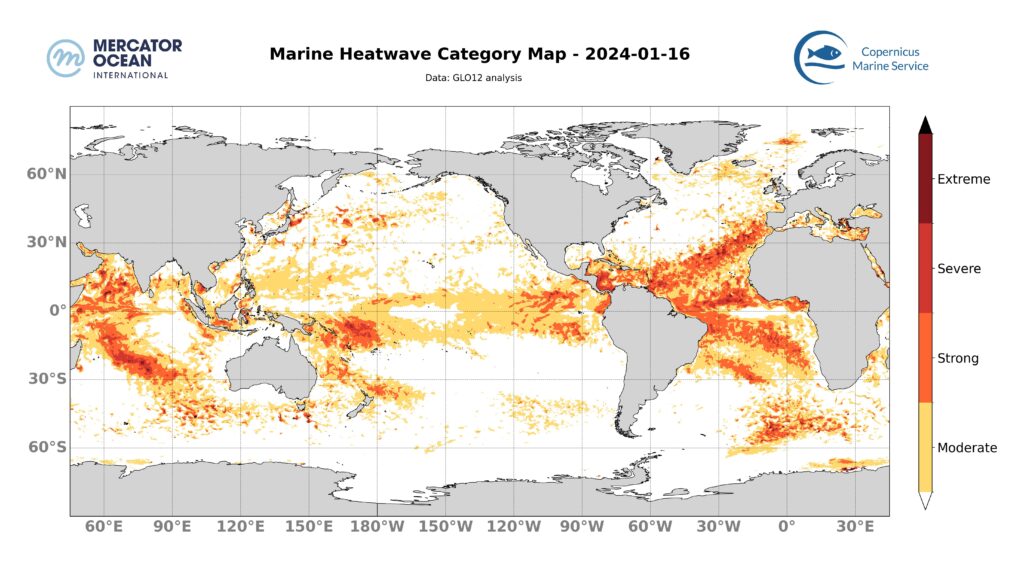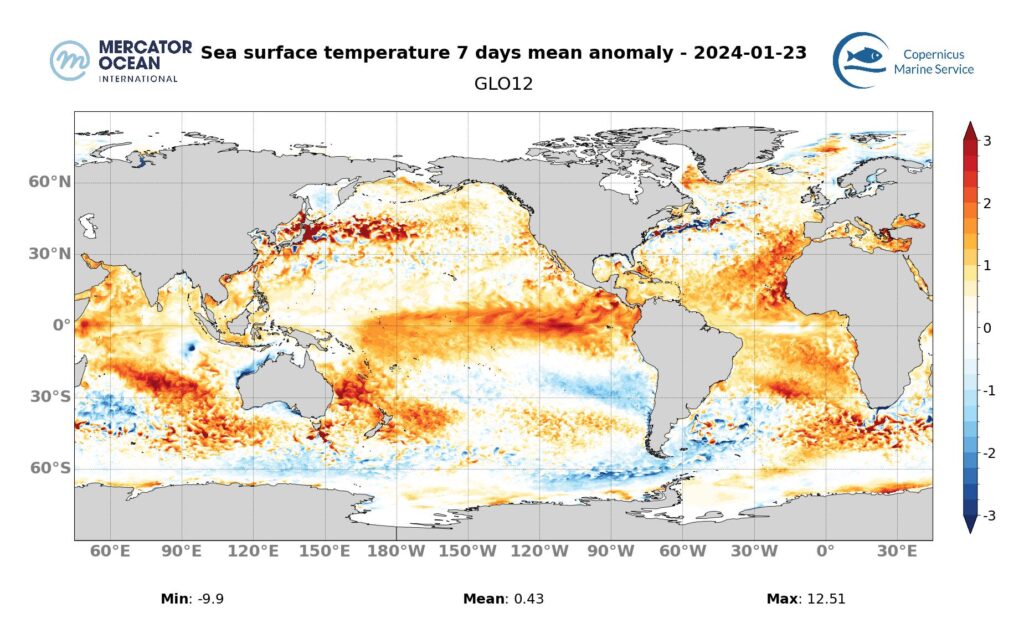Mercator Ocean International (MOi) oceanographers examine marine heatwaves across the global ocean. They analyse a variety of datasets from observation analyses (satellite sea surface temperature maps) to model analyses (assimilating satellite and in situ observations) and model forecasts.¹
Assessment for 16 January
Marine heatwave categories

- North Atlantic (Europe zone) – the marine heatwave is slightly strenghtening to the south-west of the Iberian peninsula and the Moroccan coast, with an increase in the area affected by the severe categories. The situation remains stable over the rest of the North Atlantic coast, with mainly localised moderate marine heatwaves.
- Mediterranean -The situation remains stable in the overall of the basin, with mainly moderate to severe marine heatwaves, except in the Levantine basin where the area affected by severe heatwaves is decreasing. The surface area of marine heatwaves is stable, with moderate to strong and locally extreme categories close to the coasts, mainly in the eastern Mediterranean.
- North Tropical Atlantic – the marine heatwave is still present but is slightly less intense, with a reduction in the surface area of the strong and extreme categories.
- South Tropical Atlantic – the marine heatwave is still very much present but is also decreasing slightly in intensity, with a reduction in the severe categories.
- Tropical Pacific -the marine heatwave linked to the formation of El Niño remains largely stable with moderate categories, except in the easternmost part where there is a slight increase in the area covered by severe categories.
- Indian Ocean (west) – the marine heatwave to the east of Madagascar and in the Arabian Sea increases slightly in intensity, with an augmentation of the surface areas covered by strong and locally extreme categories.
- South East Asian Seas – the marine heatwave is decreasing in intensity and is mainly in the moderate category. To the east of Papua New Guinea, the marine heatwave is increasing in intensity, with an augmentation of the surface area of strong categories and locally severe categories.
Weekly temperature anomalies
- North Atlantic (Europe zone) Ocean – 1.5 °C to 3°C
- Mediterranean Sea – 3°C
- North Tropical Atlantic Ocean – 1° C to 2.5° C
- South Tropical Atlantic Ocean– 1 °C to 2°C and 3°C locally
- Tropical Pacific Ocean– 1.5°C to 3°C
- Indian Ocean (west) – 1.5°C to 2.5°C
- South East Asian Seas – 1.5°C
Forecasts for 23 January

Europe zone
- For 23 January, the Mercator Ocean International (MOi) forecasting system predicts a continuation of the marine heatwave over the whole North Atlantic coast. The marine heatwave is decreasing lightly in intensity to the south-west of the Iberian Peninsula and the Moroccan coast.
- The situation remains stable over most of the Mediterranean sea, except in the Levantine basin where the marine heatwave is intensifying.
Global Ocean
- For 23 January, MOi forecasts show the marine heatwave in the North Tropical Atlantic will continue to diminish slightly in intensity, with the exception of the Equator where the situation remains stable.
- In the Southern Tropical Atlantic, the marine heatwave between Namibia and the tip of Brazil remains stable. The part of the marine heatwave located in the middle of the Southern Tropical Atlantic, around 30°S, is decreasing in intensity and has been completely downgraded to moderate.
- In the Eastern Tropical Pacific, the situation remains stable with mostly moderate categories and locally strong categories in the easternmost part of the basin.
- To the east of Papua New Guinea and Australia, the marine heatwave is increasing in intensity and surface area, with an increase in the surface area of the strong and severe categories.
- In the Indian Ocean, the marine heatwave is decreasing in intensity over the whole basin, with a reduction in the number of severe and heavy categories.
What are marine heatwaves?
Marine heatwaves (MHW) are extreme rises in ocean temperature for an extended period of time. They can occur at different locations in the ocean, and their magnitude and frequency have increased over the last couple of decades, with harmful impacts on ecosystems, and human activities. According to the latest report released by the Intergovernmental Panel on Climate Change (IPCC AR6 SYR), it is found with high confidence that in the near-term at 1.5°C global warming, the increasing frequency of marine heatwaves will increase risks of biodiversity loss in the oceans, including from mass mortality events.2
How are marine heatwaves calculated?
A marine heatwave is a heat episode during which the temperature is significantly higher than a certain threshold for at least 5 consecutive days.

The seasonally-varying threshold is defined on a daily basis according to a sufficiently long climatic period (in this case 1993-2016). So, for a given place and a given day, knowing all the surface temperatures observed over the last 30 years, a heatwave situation is defined as one where the temperature measured is within 10% of the maximum values observed (i.e. above the 90th quantile, see diagram), for at least 5 consecutive days.
The main characteristics of heatwaves are their duration and intensity. The intensity for a given day corresponds to the value in degrees above the 90th quantile (blue arrow), which can either be calculated as the cumulative intensity throughout the heatwave event, or the maximum intensity.
Heatwaves are categorised on the basis of their deviation from the mean temperature or anomaly (green arrow): a deviation of more than 2 times the difference between the 90th quantile and the mean corresponds to a heatwave in the strong category; a deviation of more than 3 times corresponds to a heatwave in the severe category; and a deviation of more than 4 times corresponds to a heatwave in the extreme category.
¹Analysis of datasets: OSTIA sea surface temperature observations analysis (Copernicus Marine Service), OISST sea surface temperature observations analysis (NOAA), GLO12 model (Copernicus Marine Service, Mercator Ocean International)
² IPCC AR6 SYR 4.3 https://www.ipcc.ch/report/ar6/syr/downloads/report/IPCC_AR6_SYR_LongerReport.pdf
